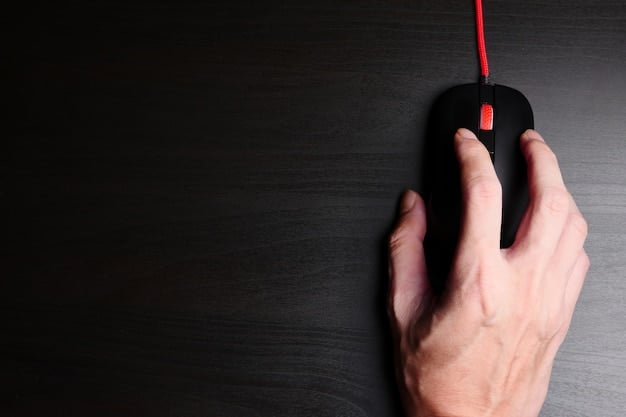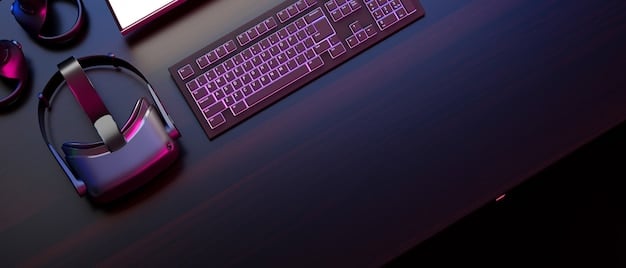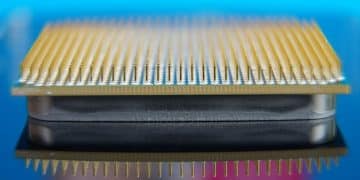Upgrade Your Experience: Choosing the Right Gaming Keyboard and Mouse for Competitive Play

Elevating your gaming performance hinges on selecting the optimal gaming keyboard and mouse, as these foundational peripherals directly impact responsiveness, precision, and overall competitive edge.
In the fiercely competitive world of esports and high-stakes online gaming, every millisecond and every precision movement matters. To truly Upgrade Your Experience: Choosing the Right Gaming Keyboard and Mouse for Competitive Play is not merely about acquiring new hardware, but about strategically investing in tools that can elevate your performance and immerse you deeper into the virtual arena.
The Core of Competitive Gaming: Why Peripherals Matter
Competitive gaming demands more than just raw skill; it requires a harmonious synergy between player and hardware. Your keyboard and mouse are not just input devices; they are direct extensions of your will, translating thoughts into in-game actions with unparalleled speed and accuracy. The nuances of their design, the technology embedded within, and their ergonomic considerations play a pivotal role in determining your responsiveness, comfort, and ultimately, your competitive standing.
Many professional gamers attribute a significant portion of their success to their meticulously chosen peripherals. This isn’t marketing hype; it’s a testament to how crucial factors like actuation force, polling rate, sensor accuracy, and macro capabilities can cumulatively shave off precious milliseconds or ensure that crucial headshot lands where intended.
Understanding Latency and Responsiveness
Latency, the delay between an action and its result, is the bane of any competitive gamer. Peripherals designed for competitive play strive to minimize this delay, ensuring your commands are registered and executed as close to instantaneously as possible. This is achieved through various technological advancements:
- Low Polling Rate: A higher polling rate (e.g., 1000Hz) means the device reports its position or state to the computer more frequently, reducing input lag.
- Fast Actuation: Keyboards with optical or speed switches register keypresses faster than traditional mechanical switches, offering an edge in high-APM (actions per minute) games.
- Dedicated Processors: Some high-end peripherals contain their own onboard processors, allowing for complex macros and custom settings to be stored directly on the device, bypassing potential software-related delays.
The pursuit of minimal latency is an ongoing battle in hardware development, with manufacturers constantly innovating to provide that imperceptible yet critical advantage. For the competitive player, investing in hardware built with this philosophy in mind is a foundational step towards unlocking their full potential.
Beyond raw speed, the feel and tactile feedback of your peripherals contribute significantly to your confidence and consistency. A keyboard with satisfying key presses helps confirm inputs, while a mouse with precise tracking allows for fluid, intuitive aiming. This blend of performance and feel creates an immersive experience that allows you to focus solely on the game.

Dissecting the Gaming Keyboard: Keys to Victory
Choosing the right gaming keyboard extends far beyond mere aesthetics; it delves into the realm of switch types, build quality, customization options, and ergonomic design. Each component plays a vital role in determining your reaction time, comfort during extended sessions, and overall in-game performance.
Mechanical vs. Membrane vs. Optical Switches
The type of switch under each keycap is perhaps the most critical decision:
- Mechanical Switches: These use individual springs and switches for each key, providing distinct tactile feedback, audible clicks (or silent linear presses), and superior durability. Popular choices like Cherry MX, Gateron, and Kailh offer various types (red, blue, brown, black) catering to different preferences for actuation force and tactile bump.
- Membrane Keyboards: More common and affordable, these use a rubber dome that depresses to make contact with a circuit board. They are quieter but often lack the tactile feedback and durability for competitive play.
- Optical Switches: A newer technology that uses a light beam to register key presses, optical switches offer near-instantaneous actuation and enhanced durability due to fewer moving parts. They are quickly gaining traction in the competitive scene for their speed.
For competitive gaming, mechanical or optical switches are almost universally recommended due to their responsiveness, consistency, and durability. The choice between them often comes down to personal preference for tactile feel and sound.
Key Rollover and Anti-Ghosting
These features are crucial for gamers who press multiple keys simultaneously. “Ghosting” occurs when a keypress isn’t registered because the keyboard’s circuitry can’t handle too many concurrent inputs. “N-key rollover” (NKRO) means every single keypress can be registered simultaneously without conflict, regardless of how many keys are pressed. Anti-ghosting addresses this by ensuring that the most common key combinations used in gaming are always registered correctly. Look for keyboards with at least 6-key rollover or, ideally, full NKRO, to ensure every command is recognized.
Beyond the switches themselves, the keyboard’s form factor heavily influences usability. Tenkeyless (TKL) keyboards, which omit the numeric keypad, are popular among gamers for providing more mouse room. Compact 60% or 65% layouts offer even greater portability and desk space savings, though they require adapting to function layers for missing keys. Full-size keyboards, while offering a complete set of keys, can be cumbersome for some competitive setups.
Customization options, such as programmable macros, on-board memory, and dedicated media controls, also add significant value. Macros allow complex sequences of commands to be executed with a single keystroke, a huge advantage in games requiring rapid input combos. On-board memory ensures your custom settings travel with the keyboard, regardless of the PC. RGB lighting, while primarily aesthetic, can also serve functional purposes, highlighting specific keybinds for different games or profiles.
Ultimately, a gaming keyboard should feel like a natural extension of your hands. Experimentation with different switch types, form factors, and features is often necessary to find the perfect match for your unique playstyle and ergonomic needs. A well-chosen keyboard can significantly reduce fatigue during marathon sessions and improve the precision of your inputs.
Mastering the Mouse: Precision and Control
The gaming mouse, often the primary aiming and navigation tool, requires an equally meticulous selection process. Its sensor, weight, shape, and additional features collectively determine your aiming precision, flick shot consistency, and overall comfort during intense gameplay.
Sensor Types: Optical vs. Laser
The heart of any gaming mouse is its sensor. For competitive play, optical sensors are generally preferred over laser sensors:
- Optical Sensors: Known for their precise tracking, especially on various surfaces, and without the acceleration issues sometimes associated with laser sensors. This translates to more consistent and predictable movement.
- Laser Sensors: While offering higher DPI (dots per inch) numbers, they can sometimes exhibit “positive acceleration,” meaning the cursor moves further than expected based on the physical movement, which can hinder pixel-perfect aiming.
High-end optical sensors, often from manufacturers like PixArt, deliver the raw accuracy and consistency demanded by esports professionals.
DPI, IPS, and Acceleration
DPI (Dots Per Inch) indicates how sensitive the mouse is. A higher DPI means the cursor moves further with smaller physical movements. While some mice offer incredibly high DPI, most competitive players use much lower settings (400-1600 DPI) for finer control. The ideal DPI is subjective and should be adjusted in conjunction with in-game sensitivity settings.
IPS (Inches Per Second) measures the maximum speed at which a mouse can be moved and still track accurately. A high IPS rating ensures the sensor doesn’t spin out or lose tracking during fast, sweeping movements. High-end gaming mice typically boast IPS ratings well over 200.
Acceleration refers to the software-based adjustment of cursor speed based on how quickly you move the mouse. For competitive play, it’s almost universally recommended to turn off mouse acceleration (raw input) in both your operating system and game settings to ensure 1:1 movement consistency.
Mouse weight and balance are also critical. Some mice offer adjustable weights, allowing players to fine-tune the feel. A lighter mouse often allows for faster flicks, while a heavier one can provide more stability for precise tracking. The balance point of the mouse can also affect how it feels in your hand, influencing comfort and perceived agility.
Ergonomics and grip style are intensely personal. Mice come in various shapes and sizes to accommodate different hand sizes and grip types: palm grip (entire hand rests on the mouse), claw grip (fingertips and base of palm make contact), and fingertip grip (only fingertips touch). A mouse that fits your grip style comfortably reduces fatigue and improves control over long gaming sessions.
Beyond the basics, features like programmable buttons, high-quality PTFE feet (for smooth gliding), and flexible, lightweight cables (or reliable wireless connectivity) contribute to the overall premium gaming experience. Wireless gaming mice have made significant strides in recent years, with technologies like Lightspeed (Logitech) and HyperSpeed (Razer) offering latency comparable to wired options, providing freedom of movement without sacrificing performance. However, ensuring stable connectivity and managing battery life remains a consideration.

Synergy and Setup: Optimizing Your Ecosystem
While selecting individual components is vital, the true power of your gaming peripherals unfolds when they work in harmony within a cohesive setup. Optimizing your entire ecosystem, from mouse pads to desk ergonomics, significantly enhances the performance benefits derived from your high-end keyboard and mouse.
The Importance of Mouse Pads
Often overlooked, the mouse pad is far more than just a surface; it’s an integral part of your aiming mechanism. Mouse pads come in various materials and sizes, designed for different playstyles:
- Control Pads: Made of softer, sometimes textured fabric, these provide more friction, allowing for extremely precise, micro-adjustments. Ideal for games requiring very fine aim.
- Speed Pads: Featuring smoother, often harder surfaces (fabric or hard plastic), these reduce friction, enabling faster and broader mouse movements. They are favored by players who rely on quick flick shots.
- Hybrid Pads: Attempt to balance control and speed, offering a versatile surface.
Large mousepads are generally recommended as they provide ample space for low-DPI aimers who utilize broad arm movements. The consistent surface and appropriate friction prevent skips or inconsistent tracking, allowing your high-performance mouse sensor to perform optimally.
Desk Height and Ergonomics
Even the best peripherals won’t compensate for poor ergonomics. An improperly set up workstation can lead to discomfort, fatigue, and even chronic injuries. Your desk height should allow your forearms to be parallel to the floor, with your wrists relatively straight when typing or using the mouse. Adjustable gaming chairs and desks can facilitate this ideal posture.
Consider the placement of your keyboard and mouse. Many competitive players prefer a slightly angled keyboard (especially TKL or 60% layouts) to allow for more natural wrist alignment and greater mouse space. The distance between your mouse and keyboard should be comfortable, avoiding unnecessary stretching or awkward angles.
Cable management, while seemingly minor, plays a role in preventing snags and ensuring smooth mouse movement. Techniques like using a mouse bungee can lift the mouse cable, eliminating drag and creating a wireless-like feel for wired mice. For wireless setups, ensuring reliable charging solutions and strategic placement of the receiver minimizes any potential connectivity issues.
Software integration across your peripherals can also streamline your setup. Many brands offer unified software platforms that allow you to manage RGB lighting, macro assignments, and sensitivity profiles for both your keyboard and mouse from a single interface. This creates a seamless experience, allowing for quick profile switching between games or applications.
Ultimately, a well-optimized gaming ecosystem is more than the sum of its parts. When your keyboard, mouse, mouse pad, and ergonomic setup work in concert, they create an intuitive and comfortable interface that allows you to focus purely on your gameplay, maximizing your competitive edge and minimizing physical strain.
Future-Proofing Your Gear: Trends and Innovations
The world of gaming peripherals is in constant flux, driven by technological advancements and the evolving demands of competitive gaming. Staying abreast of current trends and anticipated innovations can help you make informed decisions when upgrading your gear, ensuring your setup remains competitive for years to come.
Wireless Performance and Battery Life
Once plagued by latency and reliability issues, wireless gaming mice and keyboards have matured significantly. Advanced wireless technologies now offer near-wired latency, making them viable, and often preferred, for competitive play. The focus has shifted to extending battery life without adding excessive weight, with some devices offering hundreds of hours of usage on a single charge and fast-charging capabilities. Technologies like magnetic charging mats that continuously charge your mouse while in use are also gaining popularity, effectively eliminating battery concerns for desktop setups.
Lighter, More Durable Materials
There’s a strong trend towards lighter mice, particularly for FPS (First-Person Shooter) games where rapid, precise movements are key. Manufacturers are experimenting with intricate shell designs (e.g., honeycomb patterns) and advanced plastics to shed grams without compromising structural integrity. Similarly, keyboards are seeing innovations in switch longevity and more robust keycap materials (like PBT plastic) that resist wear and shine over time.
Customization and Modularity
The enthusiast market has driven a surge in highly customizable peripherals. Hot-swappable keyboard switches allow users to easily change switch types without soldering, providing unparalleled flexibility. Modular mice allow for interchangeable side panels, weights, and even top shells to better suit different grip styles and preferences. This trend empowers gamers to tailor their equipment precisely to their needs, rather than adapting to pre-set designs.
Other notable innovations include:
- Rapid Trigger Keyboards: Newer optical switches are incorporating “rapid trigger” functionality, allowing keys to re-actuate instantly on lift-off, rather than waiting for the physical reset point. This can lead to faster repeated inputs for specific actions.
- Adaptive Actuation: Some high-end keyboards are exploring switches with adjustable actuation points, allowing users to fine-tune how far a key needs to be pressed before it registers, catering to different games or personal preferences.
- Advanced Haptics: While still nascent, the integration of more sophisticated haptic feedback into peripherals could offer new layers of immersion and tactical information to players.
The ongoing development of AI-powered analysis tools that track player performance and suggest optimal peripheral settings is also on the horizon, potentially revolutionizing how gamers fine-tune their setups. While the core principles of responsiveness and precision remain, the methods by which these are achieved continue to evolve at a rapid pace.
Investing in future-proof gear doesn’t always mean buying the absolute newest technology, but rather understanding which innovations genuinely provide a tangible competitive advantage and align with your long-term gaming goals. A well-researched upgrade can serve you well for many seasons to come.
Maintenance and Longevity: Protecting Your Investment
High-performance gaming peripherals represent a significant investment, and like any precision tools, they benefit from proper care and maintenance. Extending the lifespan of your keyboard and mouse not only protects your investment but also ensures consistent performance, preventing unexpected failures during crucial moments.
Keeping Your Keyboard Pristine
Keyboards, especially mechanical ones, can accumulate a surprising amount of dust, crumbs, and debris between the keycaps. Regular cleaning is essential:
- Dusting: Use compressed air to blow out loose particles from between and under the keycaps. Do this regularly, perhaps weekly or bi-weekly depending on your environment.
- Keycap Cleaning: For deeper cleaning, carefully remove the keycaps (using a keycap puller) and wipe them down with a damp cloth or cotton swab. The exposed switches can then be gently brushed or dusted.
- Surface Wipe-Down: Use a mild disinfectant wipe or a microfiber cloth dampened with isopropyl alcohol to clean the surface of the keyboard, removing oils and grime.
Avoid spilling liquids on your keyboard. While some keyboards are spill-resistant, liquid damage is a common cause of failure. If a spill occurs, disconnect the keyboard immediately, dry it as thoroughly as possible, and allow it to air out completely before attempting to re-use it.
Optimizing Mouse Performance and Lifespan
Your gaming mouse, being constantly in motion, also requires attention:
- Sensor Cleaning: Periodically check the optical or laser sensor on the bottom of your mouse for dust or debris. A cotton swab lightly dampened with isopropyl alcohol can be used to gently clean the sensor lens.
- Mouse Feet (Skates): These PTFE (Teflon) feet on the underside of your mouse wear down over time, affecting glide. Replacement mouse feet are inexpensive and can significantly improve the longevity and smoothness of your mouse’s movement. Clean your mousepad regularly to reduce wear on the feet.
- Cable Management: For wired mice, avoid tight bends or kinks in the cable. A mouse bungee can prevent cable drag and reduce stress on the cable connection point, a common failure point. For wireless mice, ensure judicious charging practices to extend battery health.
Store your peripherals properly when not in use, especially if transporting them. Dust covers or dedicated carrying cases can prevent damage from impacts or accumulation of dirt. Software updates for your peripherals, provided by the manufacturer, are also important. These updates often include bug fixes, performance improvements, and new features, ensuring your hardware runs optimally with the latest games and operating systems.
By integrating these simple maintenance routines into your gaming habits, you can significantly prolong the life of your high-performance gear, ensuring it continues to deliver the precision and responsiveness you need to stay at the top of your game.
Budgeting for Excellence: Smart Spending on Peripherals
Upgrading your gaming peripherals doesn’t necessarily mean breaking the bank. While high-end gear can command premium prices, smart budgeting involves identifying your priorities, understanding diminishing returns, and seeking value without compromising essential competitive features.
Prioritizing Your Investment
Decide where your priorities lie. Are you an FPS player where mouse precision is paramount? Or an MMO player who benefits more from a highly programmable keyboard? Allocating a larger portion of your budget to the peripheral that offers the most direct competitive advantage for your primary game genre is a sensible strategy.
For most competitive gamers, a high-quality optical sensor mouse and a mechanical or optical keyboard are foundational. While entry-level mechanical keyboards and gaming mice exist, their performance often falls short of the precision and durability required for truly competitive play. Aim for mid-range options from reputable brands (e.g., Logitech, Razer, HyperX, SteelSeries, Corsair) that offer a proven track record of quality and performance.
Understanding Diminishing Returns
Beyond a certain price point, the performance gains from more expensive peripherals become increasingly marginal. For example, a $200 mouse might offer subtle enhancements over a $100 mouse, but these improvements might not be perceptible to the average player, or they might not translate into a significant in-game advantage for anyone outside of the elite professional tier. The sweet spot for performance-to-price ratio often lies in the mid-to-high range, typically between $70-$150 for both mice and keyboards.
Consider looking for sales and bundles. Retailers frequently offer discounts on gaming peripherals, especially during major shopping events. Bundles that combine a keyboard and mouse can sometimes offer savings, but ensure both components meet your individual quality standards.
Refurbished or open-box items from reputable sellers can also be a way to acquire high-end gear at a reduced price. Always verify the warranty and return policy when considering such options. It’s often better to buy a slightly older but highly-regarded model on sale than a brand new, cheap, unproven model.
Finally, don’t overlook “essential” accessories like a good mouse pad. A high-quality mouse pad, costing significantly less than either a keyboard or mouse, can dramatically improve the performance of even a mid-range mouse, making it a highly cost-effective upgrade. Remember that ergonomic comfort also plays a role in performance, and allocating a small part of your budget towards a comfortable wrist rest or better desk setup can enhance your overall gaming experience far beyond raw hardware.
By approaching your peripheral upgrade with a strategic mindset and a clear understanding of value, you can build a powerful and responsive gaming setup that provides a genuine competitive edge without overspending.
Personalizing Your Arsenal: Software and Customization
Beyond the physical hardware, sophisticated software and extensive customization options transform your gaming keyboard and mouse from generic input devices into truly personalized extensions of your gaming will. Leveraging these tools is crucial for extracting maximum performance and comfort.
Unlocking Potential with Software Suites
Most major peripheral manufacturers provide dedicated software suites (e.g., Logitech G HUB, Razer Synapse, Corsair iCUE). These applications are the control centers for your devices, allowing you to:
- DPI/CPI Adjustment: Precisely tune your mouse sensitivity, often with multiple profiles for on-the-fly switching.
- Key Rebinding and Macros: Assign custom functions to any key or mouse button, or create complex multi-step macros to automate in-game actions. This is invaluable in games with many abilities or complex rotations.
- RGB Lighting Customization: While largely aesthetic, customizable lighting can enhance immersion and even serve functional purposes, such as highlighting keybinds for specific games.
- Profile Management: Create and save different profiles for various games or applications, with unique settings for DPI, keybinds, and lighting. These profiles often auto-switch when a specific game is launched.
Exploring the full capabilities of your peripheral’s software can unlock hidden potentials and streamline your workflow both in and out of games. Many modern peripherals also offer onboard memory, allowing you to save your preferred profiles directly to the device, ensuring your settings are consistent even when playing on different PCs without the software installed.
Advanced Mouse Customization
Modern gaming mice offer a plethora of customization options:
- LOD (Lift-Off Distance) Control: Adjust how high you need to lift the mouse before the sensor stops tracking. A lower LOD prevents unwanted cursor movement when repositioning the mouse.
- Surface Calibration: Calibrate your mouse sensor specifically to your mouse pad surface for optimal tracking accuracy.
- Weight System: Some mice come with removable weights, allowing you to fine-tune the overall weight and balance of the mouse to your preference.
Physical customization options like interchangeable side panels or top shells allow you to adapt the mouse’s shape to better suit your grip style and hand size. This level of personalization contributes significantly to long-term comfort and consistent aiming.
For keyboards, keycap sets offer a vast world of aesthetic and tactile customization. Different keycap profiles (e.g., Cherry, OEM, SA, DSA) have varying shapes and heights, affecting typing feel and ergonomics. Materials like PBT are known for their durability and lack of shine compared to ABS, and can dramatically change the look and feel of your keyboard.
Sound customization has also become a niche within the keyboard community, with enthusiasts modifying switches (lubing, filming) and adding sound-dampening foam to alter the acoustic profile of their keystrokes. While this level of modification is often pursued by hobbyists, it underscores the depth of personalization possible.
The beauty of modern gaming peripherals lies not just in their raw performance but in their adaptability. By taking the time to delve into their software and explore available physical modifications, you can craft an arsenal that feels uniquely yours, enhancing both your competitive edge and overall gaming pleasure.
| Key Aspect | Brief Description |
|---|---|
| ⚙️ Peripheral Impact | Directly affects responsiveness, precision, and competitive advantage in gaming. |
| ⌨️ Keyboard Choices | Mechanical or optical switches are preferred for speed and durability, with N-key rollover essential. |
| 🖱️ Mouse Precision | Optical sensors are recommended for consistent tracking; consider DPI, IPS, and no acceleration. |
| 🛠️ Optimizing Setup | A suitable mouse pad, proper ergonomics, and software customization enhance overall performance. |
Frequently Asked Questions About Gaming Peripherals
▼
The most crucial factor is the switch type. Mechanical or optical switches offer superior responsiveness, tactile feedback, and durability compared to membrane keyboards. Your choice should ideally align with your preferred actuation force and sound profile, ensuring comfortable and precise key presses for competitive play.
▼
While wired mice traditionally offered lower latency, modern wireless gaming mice (using advanced technologies like Logitech Lightspeed or Razer HyperSpeed) have achieved comparable, near-zero latency. The choice largely depends on personal preference for freedom of movement versus concerns about battery life and potential interference.
▼
Not necessarily. While gaming mice offer very high DPI ranges, most competitive players use much lower DPI settings (e.g., 400-1600) combined with lower in-game sensitivity for greater precision and control. High DPI numbers are more of a marketing spec than a direct indicator of competitive advantage.
▼
For optimal performance and longevity, it’s recommended to dust your keyboard weekly with compressed air and wipe down surfaces. Deep cleaning of keycaps and mouse sensors can be done monthly or as needed. Regular maintenance prevents debris build-up that can affect responsiveness and comfort.
▼
Absolutely. While raw skill is paramount, the right gaming keyboard and mouse provide the tools for that skill to shine. They offer reduced latency, superior precision, enhanced comfort, and customizable features that can shave off valuable milliseconds, improve aim consistency, and reduce fatigue, giving you a tangible edge.
Conclusion
In the pursuit of competitive gaming excellence, the strategic choice and synergistic pairing of your keyboard and mouse are far from trivial. These devices form the direct interface between your intent and in-game execution, influencing every movement, every shot, and every ability cast. By understanding the intricacies of switch types, sensor technologies, ergonomic considerations, and the critical role of software customization, players can meticulously assemble an arsenal that not only feels intuitive but genuinely enhances their performance. Investing in quality, maintaining your gear diligently, and continuously refining your setup ensures that your peripherals serve as reliable extensions of your will, empowering you to upgrade your experience and reach your full potential in the demanding world of competitive play.





